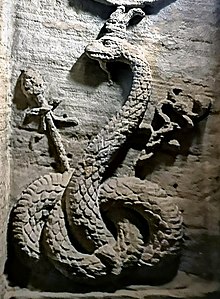Agathodaemon: Difference between revisions
Added content Tags: Reverted Mobile edit Mobile web edit |
Added content Tags: Reverted Mobile edit Mobile web edit |
||
| Line 11: | Line 11: | ||
| name = Agathos Daimon |
| name = Agathos Daimon |
||
| deity_of = Spirit of fertility, good luck, grain, harvest, health, home, protection, wealth and wisdom |
| deity_of = Spirit of fertility, good luck, grain, harvest, health, home, protection, wealth and wisdom |
||
Psychopomp and Divine Guardian |
Psychopomp and Divine Guardian |
||
| gender = Male |
| gender = Male |
||
Revision as of 13:35, 2 May 2023
| Agathos Daimon | |
|---|---|
Spirit of fertility, good luck, grain, harvest, health, home, protection, wealth and wisdom
Psychopomp and Divine Guardian | |
 | |
| Major cult centre | Alexandria, Egypt |
| Animals | Snakes |
| Symbol | Horn of Plenty |
| Day | 2 February (Gregorian) 25 Tybi (Egyptian) |
| Gender | Male |
| Consort | Tyche Agathe |
| Equivalents | |
| Pre-Ptolemaic Egyptian | Shai |
Agathos Daimon (ἀγαθός δαίμων, agathós daímōn, lit. 'noble spirit')[a] originally was a lesser deity (daemon) of classical ancient Greek religion and Graeco-Egyptian religion. In his original Greek form, he served as a household god, to whom, along with Zeus Soter, libations were made after a meal. In later (post-)Ptolemaic antiquity he took on two partially distinct roles; one as the Agathos Daimon a prominent serpentine civic god, who served as the special protector of Alexandria. The other as a genus of serpentine household gods, the Agathoi Daimones, individual protectors of the homes in which they were worshipped.[1]
Greek classical period
Though little noted in Greek mythology (Pausanias conjectured that the name was merely an epithet of Zeus),[2] he was prominent in Greek folk religion;[3] it was customary to drink or pour out a few drops of unmixed wine after the meal to honor him and Zeus after every symposium or formal banquet, as was done for Hestia prior to the meal.[4] In Aristophanes' Peace, when War has trapped Peace (Εἰρήνη Eirene) in a deep pit, Hermes comes to give aid: "Now, oh Greeks! is the moment when, freed of quarrels and fighting, we should rescue sweet Eirene and draw her out of this pit... This is the moment to drain a cup in honor of the Agathos Daimon." A temple dedicated to them was situated on the road from Megalopolis to Maenalus in Arcadia.[5]
Agathos Daimon was the spouse or companion of Tyche Agathe (Τύχη Ἀγαθή, "Good Fortune"; Template:Lang-la). "Tyche we know at Lebadeia as the wife of the Agathos Daimon, the Good or Rich Spirit".[6][7] Their numinous presence could be represented in art as a serpent or more concretely as a young man bearing a cornucopia and a bowl in one hand, and a poppy and an ear of grain in the other.[6]
Egyptian late antiquity
In the syncretic atmosphere of late Antiquity, agathodaemons could be bound up with Egyptian bringers of security and good fortune: a gem carved with magic emblems bears the images of Serapis with crocodile, sun-lion and Osiris mummy surrounded by the lion-headed snake Chnum–Agathodaemon–Aion, with Harpocrates on the reverse.[8]
See also
Footnotes
- ^ Sometimes written as Agathodaemon (Ancient Greek: ἀγαθοδαίμων, agathodaímōn)
References
- ^ Ogden, Daniel (2013). Drakōn : dragon myth and serpent cult in the Greek and Roman worlds. Oxford University Press. pp. 286–309. ISBN 978-0-19-955732-5. OCLC 837855776.
- ^ Pausanias, Description of Greece, viii. 36. § 3
- ^ Martin P. Nilsson, Greek Folk Religion. (Columbia University Press), 1981:33, 70, 73.
- ^ Fraser, Peter M. (1972). Ptolemaic Alexandria. Vol. I. Oxford: Claredon Press. p. 210.
- ^ Schmitz, Leonhard (1867), "Agathodaemon", in Smith, William (ed.), Dictionary of Greek and Roman Biography and Mythology, vol. 1, Boston, p. 65, archived from the original on 2005-10-26, retrieved 2008-05-05
{{citation}}: CS1 maint: location missing publisher (link) - ^ a b Chisholm 1911, p. 371.
- ^ Harrison 1922, pp. 355–ff, 543.
- ^ Illustrated in W. Fauth, Helios Megistos: zur synkretistischen Theologie der Spätantike (Leiden: Brill) 1995:85.
- This article incorporates text from a publication now in the public domain: Chisholm, Hugh, ed. (1911). "Agathodaemon". Encyclopædia Britannica. Vol. 1 (11th ed.). Cambridge University Press. p. 371.
Bibliography
- Harrison, Jane Ellen (1922). Prolegomena to the Study of Greek Religion (3rd ed.). pp. 355–ff, 543.
External links
- Theoi.com: Greek and Latin sources in translation
